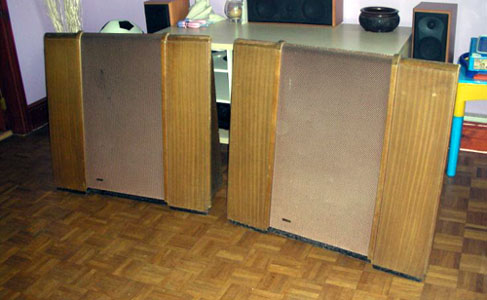 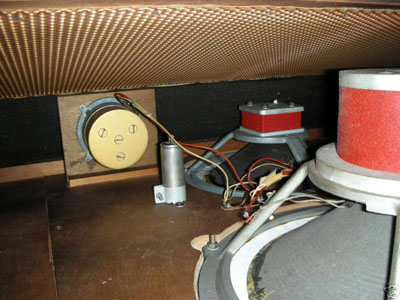
The Super 3 was used in the Wharfedale SFB (sand filled
baffle) mounted on the rear of the cabinet, pointing
upwards.
(images nicked on eBay)
Download
Wharfedale 1956 review, zip file, 700 KB
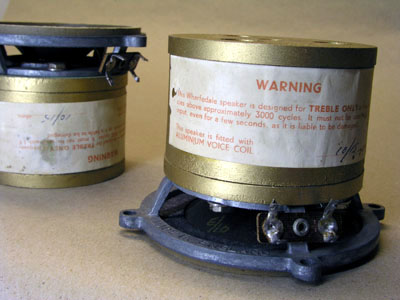
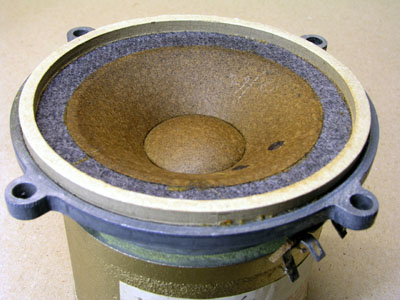
I've
never seen so much alnico getting so little paper
swinging. Massive.
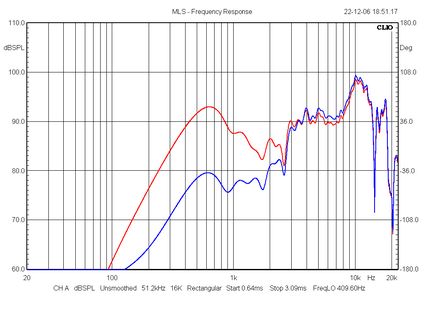 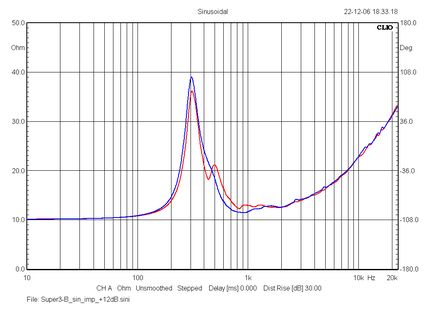
Left: Red = The Super 3
on a 30 x 40 cm open baffle. Blue = same driver
through 4 uF capacitor. This was the only
"crossover" in the SFB speaker.
Right: impedance of both drivers. Not bad at all
after all these years.
I have to say the SPL to the left
was a bit disapointing. 10 dB peak at 10 kHz and
10 dB dip at 2 kHz. What am I going to use these
drivers for? I had hoped for 93-95 dB at 4-15
kHz, but this more seems like 90 dB, plus/minus
10 dB!
My first thought was that the dip at 2 kHz was
really strange. I added a wider baffle and - as
expected - nothing happened. Having just done the
Super 8, I took a look at the felt surround,
which looked fairly solid, but putting a straw to
the felt material you can blow right through it.
Once more?!
|
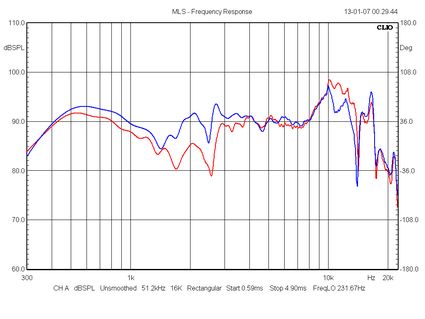 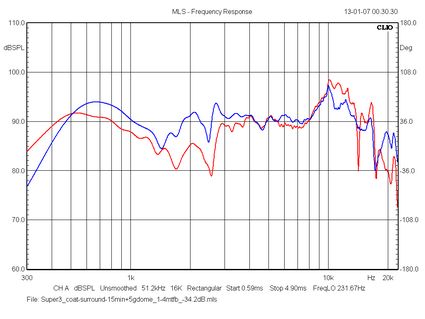
Left: Sample A: Red =
as-is, blue = after coating of felt surround.
Right: Sample B: Red = as-is, blue = after
coating of felt surround.
Same picture for both tweeters. Coating of the
surround brings up the response in the 1-4 kHz
region and overall we have a better response from
1-10 kHz. Sample A has a severe dip around 14
kHz. A little strange as sample B hasn't.
I still wonder whether the open surrounds were
intentional, but I can't make sense of it. Why
would anyone want a dip at 1-4 kHz? This is a
3" driver with a possible response down to
at least 300 Hz given the rather rigid
suspensions and I cannot find a rationale for
this. It must have been clearly measurable at the
time the tweeters were designed. Unless this was
meant only to perform above 3-5 kHz with a single
capacitor and the dip below point of crossover
was just seen welcome. I doubt it.
|
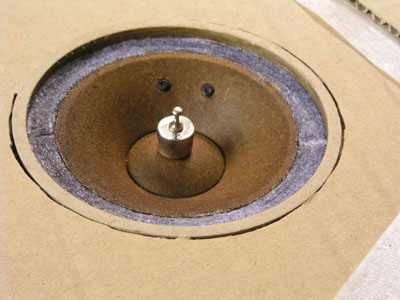 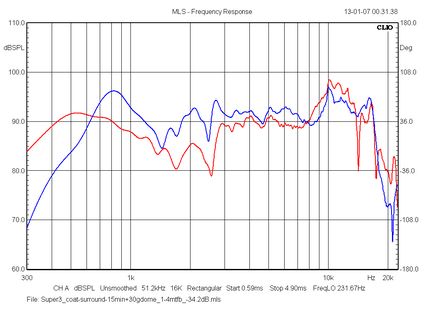
Left: Sample A with a 5
grams weight on top of the dust cap. Response to
the left; takes away the dip a 14 kHz. Hmm... I
guess there are some resonances in the dust cap,
probably augmented by an un-damped polepiece.
Actually I tried placing a 30 (!) grams weight on
the dust cap without any decline in overall
sensitivity. This dust cap doesn't appear
necessary at all. Could probably be replaced by a
phase plug, but I'll keep my scalpel away until
further. I can't bear cutting into these nice
vintage drivers.
|
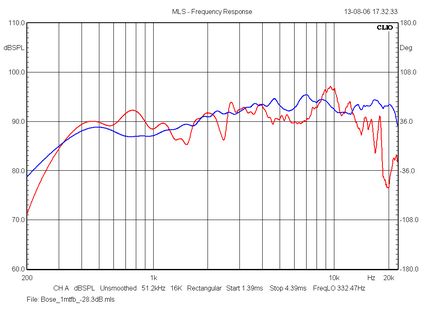 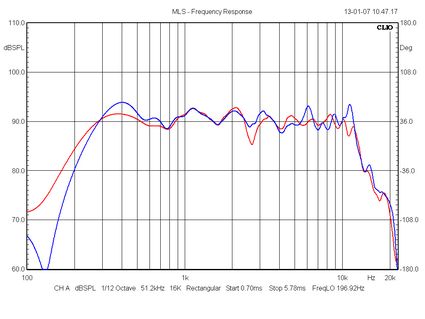
To finish this Super 3
report, let's take a step back and try not to
think of mint condition ~40 years old drivers,
huge alnico magnets and 16 ohms voice coils wound
on paper formers.
What have we got here? A 3 inch paper driver with
a sensitivity around 92-93 dB. Well, there are a
lot of 3-inch driver around and to the left we
see a Bose satellite driver (blue graph), which I
checked recently. Red = Super 3. Now, this is two
drivers in parallel, which adds to sensitivity,
but the response.....from 300 Hz to a clean 20
kHz! Now these Bose guys know what they want. I'm
very impressed. Had these drivers had a small
baffle, they would have been flat down to 3-400
Hz. From the Bose speakers you have a response
from around 300 Hz to 20 kHz. I tried setting
them up in all corners, close to the wall towards
the ceiling and did a 32 ms window reading and
yes, it's a terrible thing to put speakers in
these places, but a +/- 4dB could be achieved
from 300 Hz to 20 kHz. I find the sound from
these speakers very good indeed. No crossover in
the upper midrange or treble. Only sad they're
mostly trying to reach a sub hidden behind the
sofa. All the good stuff between 100 and 300 Hz
is missing.
To the right we have two samples of el cheapo JBL
drivers made in Korea. Pic to the right below.
Not bad at all. Basically flat from 300 Hz to
10-12 kHz.
What these two examples are missing is only some
2-4 dB sensitivity to be suitable for some
vintage set-up. Unfortunately the very small
Fostex drivers are not very sensitive. They might
have done much better here compared to most
vintage 3" tweeters. And none of the Tangband
full-range drivers are
rated above 90 dB either.
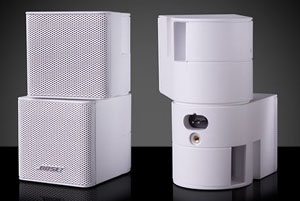 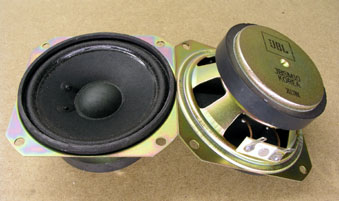
Left: Tiny Bose satellites. Right: Korean JBL
3" drivers.
08-11-2011
Greetings Troels...wonderful site, tremendous work and research on your
part!
Just a correction regarding your entry on the Super 3 tweeters as
pictured..these were not part of the SFB 3 configuration. The super 3 in
that case was specially designed utilizing a metal dustcap (see pic) to
extend its response. Some documentation and material written by Gilbert
Briggs himself also suggests that the voice coil of the SFB 3 Super 3
Tweeter were longer as well. The Super 3`s in your pics were used in the
early W70 and W90 models. Best regards. Leo
|